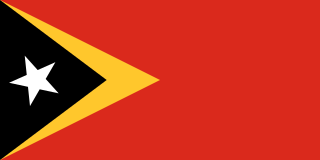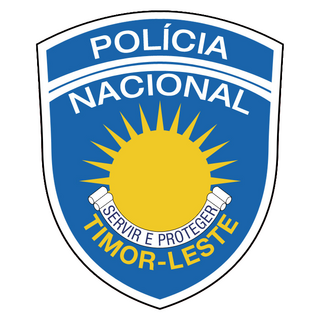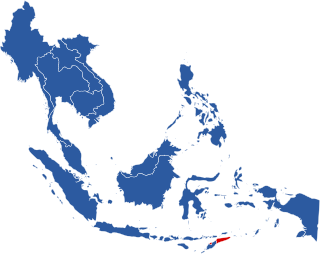| |||||
| Decades: | |||||
|---|---|---|---|---|---|
| See also: | |||||
The following lists events that happened during 2002 in Timor-Leste (formerly known as East Timor).
| |||||
| Decades: | |||||
|---|---|---|---|---|---|
| See also: | |||||
The following lists events that happened during 2002 in Timor-Leste (formerly known as East Timor).

Timor-Leste, officially the Democratic Republic of Timor-Leste, is a country in Southeast Asia and Oceania. The country comprises the eastern half of the island of Timor and the nearby islands of Atauro and Jaco. The first inhabitants are thought to be descendant of Australoid and Melanesian peoples. The Portuguese began to trade with Timor by the early 16th century and colonised it throughout the mid-century. Skirmishing with the Dutch in the region eventually resulted in an 1859 treaty for which Portugal ceded the western half of the island. Imperial Japan occupied East Timor during World War II, but Portugal resumed colonial authority after the Japanese surrender.

The political system in Timor-Leste is a unitary semi-presidential representative democratic republic, whereby the Prime Minister of Timor-Leste is the head of government and the President of Timor-Leste functions as head of state. Timor-Leste has a multi-party system. Executive power is exercised by the president and the government. Legislative power is vested in both the government and the National Parliament. The Judiciary is independent of the executive and the legislature. The East Timorese constitution was modelled on that of Portugal, with lesser power given to the president. The country is still in the process of building its administration and governmental institutions. The Economist Intelligence Unit rated East Timor a "flawed democracy" in 2022.

The economy of Timor-Leste is a low-income economy as ranked by the World Bank. It is placed 140th on the Human Development Index, indicating a medium level of human development. 20% of the population is unemployed, and 52.9% live on less than $1.25 a day. About half of the population is illiterate. At 27%, Timor-Leste's urbanisation rate is one of the lowest in the world.

In Timor-Leste, transportation is reduced due to the nation's poverty, poor transportation infrastructure.

The Timor Leste Defence Force is the military of East Timor. The F-FDTL was established in February 2001 and comprises two infantry battalions, small naval and air components and several supporting units.

After the referendum on independence on 30 August 1999, Timor-Leste became an independent nation on 20 May 2002 and began initiating diplomatic relations with the rest of the global community.

"Pátria" is the national anthem of Timor-Leste. It was originally adopted when East Timor unilaterally declared its independence from Portugal in 1975. However, this usage would be short-lived, when the country was invaded by Indonesia. It was officially re-adopted when the independence of Timor-Leste was finally restored in 2002 following a United Nations intervention.

The national flag of Timor-Leste consists of a red field with the black isosceles triangle based on the hoist-side bearing a white five-pointed star in the center superimposed on the larger yellow triangle, also based on the hoist-side, that extends to the center of the flag.

The Timor-Leste national football team, recognized as Timor-Leste by FIFA, is the national team of Timor-Leste and is controlled by the Federação de Futebol de Timor-Leste (FFTL). They became a member of FIFA on 12 September 2005.

The National Parliament is the unicameral national legislature in Timor-Leste. It was created in 2001 as the Constituent Assembly while the country was still administered by the United Nations, but renamed itself to the National Parliament with the attaining of national independence on 20 May 2002.

Radio e Televisão de Timor-Leste, E.P. is the national state radio and television broadcaster in East Timor.

Francisco Guterres, popularly known as Lú-Olo, is an East Timorese politician who served as 6th president of East Timor from 2017 to 2022. He is also the president of the political party Fretilin, and he was the first president of the National Parliament of East Timor from 2002 to 2007.

The National Police of East Timor or PNTL is the national police force of East Timor.

The majority of the population of Timor-Leste is Christian, and the Catholic Church is the dominant religious institution, although it is not formally the state religion. There are also small Protestant and Sunni Muslim communities.

Timor-Leste, also known as East Timor, officially the Democratic Republic of Timor-Leste, is a country in Southeast Asia. It comprises the eastern half of the island of Timor, the exclave of Oecusse on the island's north-western half, and the minor islands of Atauro and Jaco. The western half of the island of Timor is administered by Indonesia. Australia is the country's southern neighbour, separated by the Timor Sea. The country's size is 14,950 square kilometres (5,770 sq mi). Dili, on the north coast of Timor, is its capital and largest city.

East Timor–Russia relations are the bilateral relations between East Timor and Russia. Neither country has a resident ambassador. Russia was one of the first countries to recognize East Timor's independence and took part in nearly all UN aid programs, providing food and relief personnel, including civil and transport aviation pilots.

The accession of Timor-Leste to the Association of Southeast Asian Nations is a process that started following the independence of the country in 2002 when its leaders stated that it had made a "strategic decision" to become a member state of the Association of Southeast Asian Nations (ASEAN) in the future. The country officially applied for membership in 2011.

Bilateral relations exist between Australia and East Timor. The two countries are near neighbours with close political and trade ties. East Timor, the youngest and one of the poorest countries in Asia, lies about 610 kilometres northwest of the Australian city of Darwin. Australia has played a prominent role in the young republic's history.

Oecusse, also known as Oecusse-Ambeno and formerly just Ambeno, officially the Special Administrative Region Oecusse-Ambeno, is an exclave, municipality and the only special administrative region (SAR) of East Timor.